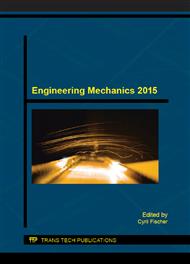[1]
Baseley, S., Ehret, C., Greif, E., &Kliffken, M. Hydraulic Hybrid Systems for Commercial Vehicles. SAE Technical Paper 2007-01-4150, doi: 10. 4271/2007-01-4150. (2007).
DOI: 10.4271/2007-01-4150
Google Scholar
[2]
J. Nevrlý, Z. Němec, P. Noskievič, Use of Matlab/Simulink and Amesim for simulation of hydraulic recovery of kinetic energy. In Proceedings of The 4th International conference ANTiM, University UNION – Nikola Tesla, Belgrade, Serbia (2014).
Google Scholar
[3]
T. Panáček, M. Klapka, Z. Němec, Optimization of valve manifold timing sequence using differential evolution algorithm. In Engineering mechanics 2014, Book of full texts. Prague: Institute of Termomechanics, Academy of Sciences of the Czech Republic, pp.468-471 (2014).
Google Scholar
[4]
J. Nevrlý, Z. Němec, Valve timing of recovery module of road roller. Hydraulika a pneumatika, 2014, vol. 31, nr. 1, pp.8-12. ISSN: 1335- 5171 (2014).
Google Scholar
[5]
A. Pourmovahed, N. H. Beachley, F. J. Fronczak, Modelling of a hydraulic energy regeneration system - part I: Analytical treatment. ASME J. Dyn. Sys., Meas., and Control, Vol. 114. pp.155-159 (1992).
DOI: 10.1115/1.2896497
Google Scholar
[6]
A. Pourmovahed, N. H. Beachley, F. J. Fronczak, Modelling of a hydraulic energy regeneration system - part II: Experimental program. ASME J. Dyn. Sys., Meas., and Control. Vol. 114. pp.160-165, (1992).
DOI: 10.1115/1.2896498
Google Scholar
[7]
P. L. Matheson, J. S. Stecki, Optimisation of a hybrid diesel-hydraulic automotive powertrain using ADVISOR, Matlab & Simulink. In Australian J. Mech. Eng., pp.43-50. Engineers media for engineers, Australia. (2005).
DOI: 10.1080/14484846.2005.11464479
Google Scholar
[8]
X. Wang, J. Jiang, Optimization Matching of Wheel Drive Hydraulic Hybrid Vehicle Components Based on Adaptive Simulated Annealing Genetic Algorithm, Proceedings of the 2009 IEEE International Conference on Mechatronics and Automation, pp.1962-1967. (2009).
DOI: 10.1109/icma.2009.5244986
Google Scholar
[9]
X. Wang, Y. Ancai, Ch. Wie, Optimal Matching on Driving System of Hydraulic Hybrid Vehicle. In Procedia Engineering, Elsevier, Vol. 15, p.5294–5298. ISSN 1877-7058. doi: 10. 1016/j. proeng. 2011. 08. 981 (2011).
DOI: 10.1016/j.proeng.2011.08.981
Google Scholar
[10]
R. Storn, Differential Evolution for Continuous Function Optimization [online] (cit. 2. 8. 2013). Available on http: /www. icsi. berkeley. edu/~storn/code. html.
Google Scholar


